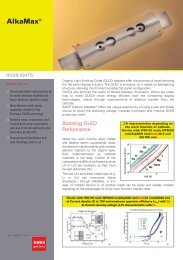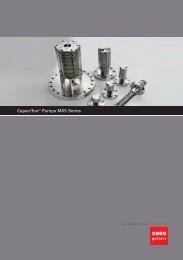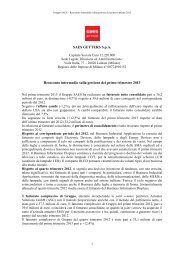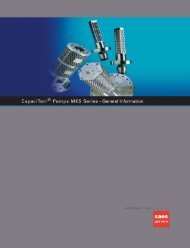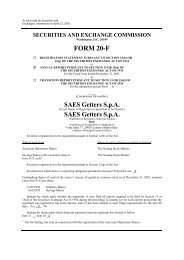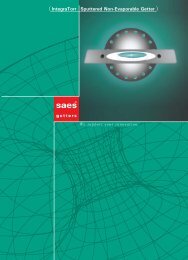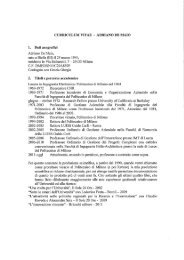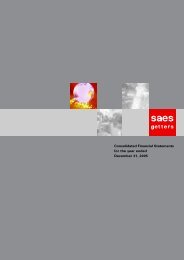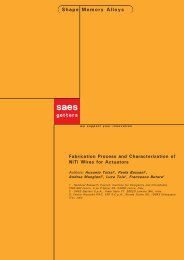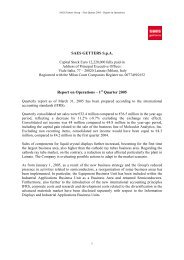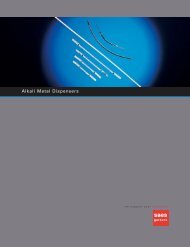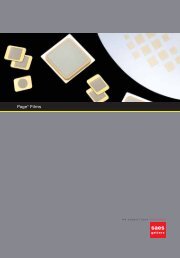sorb ac general.pdf - SAES Getters
sorb ac general.pdf - SAES Getters
sorb ac general.pdf - SAES Getters
- No tags were found...
Create successful ePaper yourself
Turn your PDF publications into a flip-book with our unique Google optimized e-Paper software.
Air VentingOpening the v<strong>ac</strong>uum chamber where MK5 SORB-AC pumps are mounted should be performed onlywhen the getter material is at room temperature or at least below 50°C. After e<strong>ac</strong>h air exposure, anew re<strong>ac</strong>tivation of the getter cartridge is required.A progressive reduction of pumping speed for hydrogen and <strong>ac</strong>tive gases is observed after successiveexposures to air. After about 30 air exposures at room temperature followed by re<strong>ac</strong>tivation, St 707cartridges at 280°C still have a pumping speed for hydrogen of about 40% of the original pumpingspeed.If dry nitrogen is used instead of air, the pumping speed reduction after the same number of exposures,appears to be lower (residual pumping speed still about 80% of the initial value, see Figure 8). Thisis because, for the first cycles, the effect of the re<strong>ac</strong>tivation which follows a nitrogen exposure isgreater than the new contamination caused by exposure to nitrogen. Further improvement is obtainedwhen pure argon is used as a protective gas during maintenance operations.120Percentage of Initial Pumping Speed10080604020NitrogenAir00 5 10 15 20 25 30 35Number of ExposuresFigure 8 - effects of air and N 2 exposuresV<strong>ac</strong>uum Failure During Activation or RegenerationDuring <strong>ac</strong>tivation or regeneration of SORB-AC cartridge pumps, air must not be allowed to suddenlyenter the v<strong>ac</strong>uum system. Such an occurrence could cause burning, i.e. a quick oxidation, of thecoated strip. This happens if the temperature of the cartridge at the moment of v<strong>ac</strong>uum failure isabove 200°C in the case of St 707 cartridges. The burning is slow and progressive, not explosive.Should a serious v<strong>ac</strong>uum failure take pl<strong>ac</strong>e when the temperature of the cartridge is high, althoughbelow the above-indicated values, permanent damage of varying degrees will occur <strong>ac</strong>cording totemperature, but not burning. In this case, pumping char<strong>ac</strong>teristics of the getter material would beaffected to a greater or lesser extent depending on temperature and time. Also, in these cases, a moreefficient recovery of gettering efficiency can be obtained by using a re<strong>ac</strong>tivation procedure at atemperature higher than the normally adopted value.Excessive Heating of the CartridgeThe St 707 cartridges use constantan as a substrate material, and they should not be heated totemperature over 750°C to avoid possible copper or manganese evaporation from the material. Attemperatures over 850°C, it is possible to have the formation of eutectic compounds between copperand zirconium, which could cause melting of the cartridge.Mechanical ShocksDue to the mechanical char<strong>ac</strong>teristics of the insulating elements of the heater (ceramic sp<strong>ac</strong>ers),particular care must be observed in handling during assembly (and removal) of the pumping system.Accidental dropping and similar mechanical shock could result in breakage of the insulating elementswith possible short circuits of the electrical path.We support your innovation7



